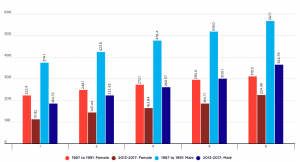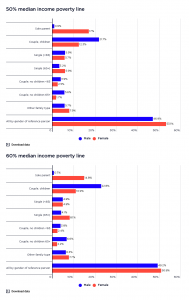This graph shows where those identifying as male and female are placed in the household income rankings. Generally, the individual incomes of women are lower than those of men. In 2016, median earnings from paid work (both full- and part-time) for women were 71% of those for men, according to the Australian Bureau of Statistics. However, this website compares income groups based on the income of their household (assuming that incomes are equally shared within households), rather than individual incomes. As a result, income inequality between men and women can be masked. The impacts of gender inequality only become apparent when women live independently of men.
2017-18: Households with female main earners and children were twice as likely (29%) to be in the lowest 20% by income compared with households with male main earners and children (14%). Amont sole parent families, the majority of which have female main earners, 29% were in the lowest 20% income group. In contrast, 18% of households with male main earners and children, compared wtih 11% of households with female main earners and children, were in the highest 10% income group.
2015-16: Women are slightly more likely to be in low-income households, with 21% of women located in the lowest 20% income group. This reflects the fact that most sole parent households and older people living alone are households where the reference person is female, and those households are found disproportionately in the lowest 20%.




